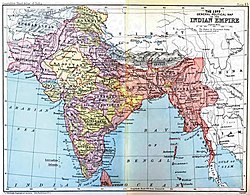Presidency of Madras
| Madras Presidency | |||||
| Presidency of British India | |||||
|
|||||
|
Flag |
|||||
| The Madras Presidency in 1913 | |||||
| Historical era | New Imperialism | ||||
| • | Established | 1652 | |||
| • | Disestablished | 1947 | |||

Imperial entities of India
|
|
| Dutch India | 1605–1825 |
|---|---|
| Danish India | 1620–1869 |
| French India | 1769–1954 |
|
|
|
| Casa da Índia | 1434–1833 |
| Portuguese East India Company | 1628–1633 |
|
|
|
| East India Company | 1612–1757 |
| Company rule in India | 1757–1858 |
| British Raj | 1858–1947 |
| British rule in Burma | 1824–1948 |
| Princely states | 1721–1949 |
| Partition of India |
1947
|
|
|
|
Flag
The Madras Presidency, or the Presidency of Fort St. George and also known as Madras Province, was an administrative subdivision (presidency) of British India. At its greatest extent, the presidency included most of southern India, including the whole of the Indian states of Tamil Nadu and Andhra Pradesh and parts of Odisha, Kerala, Karnataka, Telangana, and the union territory of Lakshadweep. The city of Madras was the winter capital of the Presidency and Ootacamund or Ooty, the summer capital. The island of Ceylon was a part of Madras Presidency from 1793 to 1798 when it was created a Crown colony.
In 1639, the English East India Company purchased the village of Madraspatnam and one year later it established the Agency of Fort St George, precursor of the Madras Presidency, although there had been Company factories at Machilipatnam and Armagon since the very early 1600s. The agency was upgraded to a Presidency in 1652 before once more reverting to its previous status in 1655. In 1684, it was re-elevated to a Presidency and Elihu Yale was appointed as president. In 1785, under the provisions of Pitt's India Act, Madras became one of three provinces established by the East India Company. Thereafter, the head of the area was styled "Governor" rather than "President" and became subordinate to the Governor-General in Calcutta, a title that would persist until 1947. Judicial, legislative and executive powers rested with the Governor who was assisted by a Council whose constitution was modified by reforms enacted in 1861, 1909, 1919 and 1935. Regular elections were conducted in Madras up to the outbreak of the Second World War in 1939. By 1908, the province comprised twenty-two districts, each under a District Collector, and it was further sub-divided into taluks and firqas with villages making up the smallest unit of administration.
...
Wikipedia


